Whale watching for landlubbers
February 17, 2011
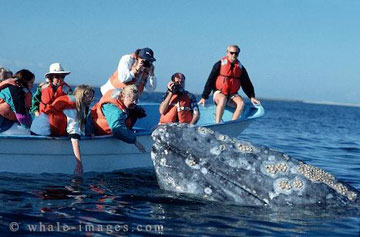 We can’t guarantee you’ll see dozens of whales at “Whale of a Weekend,” but you can definitely strap on some blubber for a marine mammal’s-eye-view of what it feels like to be a Pacific gray whale.
We can’t guarantee you’ll see dozens of whales at “Whale of a Weekend,” but you can definitely strap on some blubber for a marine mammal’s-eye-view of what it feels like to be a Pacific gray whale.
The gray whales are on the last leg of a 10,000 mile voyage from Alaskan waters to their breeding grounds off the coast of Baja California. Binoculars and field guides will be available for spotting whales and other wildlife from the Santa Monica Pier’s observation deck, and experts from the American Cetacean Society, the oldest whale conservation group in the country, will be on hand to guide you through the whale-watching experience.
Get to know the whales and other marine life with Aquarium naturalists who teach using films, presentations, and games. Feel samples of the whale’s baleen (the filtering structure they use to feed.) You can also try on a simulated coat of blubber to understand how whales stay warm in icy seas.
In addition to educational activities, there will be face painting, whale-themed crafts, and a life-size chalk drawing of a whale that the public will help color in (the whales grow to more to 50 feet in length, so many hands are needed.)
Heal the Bay’s Santa Monica Pier Aquarium will host the event from 12:30 to 5 p.m. on Saturday, Feb. 19 and Sunday, Feb. 20. The Aquarium is located at the beach level of the Santa Monica Pier, 1600 Ocean Front Walk. The event is free for children under 12 and $3 for everyone else, with a $5 suggested donation. (Added bonus: If you’re there on Sunday at 3:30 p.m., you can catch the popular weekly feeding at the shark tank.)
Heal the Bay is a nonprofit organization dedicated to ensuring coastal areas of Southern California are safe, healthy and clean. A 2:30 p.m. presentation on Saturday and Sunday will focus on how changing ocean temperatures are affecting whale migration by changing their feeding patterns. Heal The Bay’s Tara Crow, who helped organize this event, described a recent feeding phenomenon that she observed:
“This year there were about 50 blue whales seen in the Santa Monica Bay. These kinds of numbers have not been recorded before in our Bay, at least in recent history. It was amazing to be on a boat five minutes out of Redondo Harbor and see blue whales all around, feeding on krill. We’re not sure what brought the krill and the blues into the Bay this year—but all in all we have had a very unusual year as ocean temperatures go. And as a result we are seeing a lot of things we don’t usually get to see here. Much more research and data will need to be collected before we can determine if this is simply a weird weather year or if this is a result of an overall change in climate.”
Whether you’re a conservationist, whale geek or just an ocean-lover, come down to the pier this weekend and enjoy the majesty of these massive mammals with a dedicated group that works to protect them and their habitat.
Posted 2/17/11
And the Oscar for best detour goes to…
February 17, 2011
In LA, we have five seasons: winter, spring, summer, fall…and awards. This Sunday, the glitz and glam of the 83rd annual Academy Awards will be ushered in with a few road closures and some temporary changes in Metro service. Arm yourself with information to ensure smooth travel should you find your self headed to, or passing through, the area around Hollywood & Highland.
Street closures begin on Monday, Feb. 21, and some lane and sidewalk closures have already begun. A full list of street and sidewalk closures is available on the Oscars’ website.
The Hollywood/Highland Metro Red Line station will be closed Sunday Feb. 27, and there will be bus detours leading up to the event. Visit Metro’s website for a list of detours and closures.
As for navigating your office Oscar pool…you’re on your own.
Posted 2/17/11
The fight of their lives
February 17, 2011
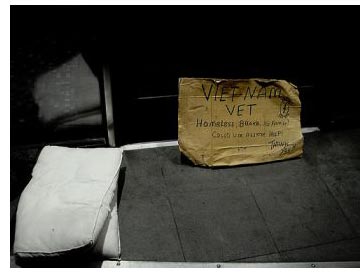 It’s hard to imagine a day when thousands of the homeless people on our streets were spit-and-polish members of the armed services, dispatched to points across the nation and throughout the world. Now, here they are in Los Angeles, an estimated 7,000 of our former troops, waging a war of survival.
It’s hard to imagine a day when thousands of the homeless people on our streets were spit-and-polish members of the armed services, dispatched to points across the nation and throughout the world. Now, here they are in Los Angeles, an estimated 7,000 of our former troops, waging a war of survival.
These men and women are no longer symbols of our military might; they are evidence of our shameful failure to protect them at home.
In interviews with outreach workers, they tell of lives plagued by sickness and despair. They’ve been stricken with everything from heart disease to tuberculosis to Hepatitis C and cancer. They’ve battled the demons of alcoholism and addiction. They’ve suffered assaults on the streets and been hospitalized and jailed numerous times—an expense that falls squarely on the public.
Help, however, is on the way.
On Wednesday, the Department of Veterans Affairs and a collection of federal, state and local agencies announced the creation of Veterans to Home, Project 60, a program aimed at providing permanent housing and support services to 60 veterans who’ve been identified as the most likely to die on the streets. It’s a modest but monumental step forward.
The veterans’ program is modeled after Project 50, an effort I’ve championed to provide permanent supportive housing to 50 of Skid Row’s most vulnerable and chronically homeless individuals.
The concept, taking root in cities across the country, is that if you first give a person a permanent home, then they’ll be far more likely to take advantage of the services made available to them, including health and mental health help. Taxpayers, in turn, will be spared the enormous costs of hospitalizations and incarceration.
Project 50 has demonstrated that the concept works.
The truth is that a concerted effort like this for our struggling veterans was long overdue. These kinds of homeless programs require immense cross-jurisdictional cooperation, something that isn’t a hallmark of government. But in this case, the cause has trumped the rivalries.
I salute Veterans Affairs for rising to the challenge, providing much needed housing vouchers, as well as the services of mental health and substance abuse experts.
The agency has tremendous resources, far more than any county in the country and far more than any nonprofit. If the VA becomes convinced that this is the way to solve veteran homelessness, then a tsunami of housing and services could follow for a significant slice of our homeless population.
I’d also like to thank our four private partners in this effort who have been in the forefront of the “housing first” movement—OPCC, Step Up on Second, St. Joseph Center and San Fernando Valley Community Mental Health Center. These organizations are supplying housing for the veterans and sharing their expertise with federal officials.
So next November, on Veterans Day, I know that I’ll not only be remembering those we’ve lost to battle but also those enduring a living hell on our streets in Los Angeles.
For more on this effort, here’s a column by Los Angeles Times columnist Steve Lopez and an editorial that recently appeared in The New York Times.
Posted 2/17/11
Ansel Adams and a vanished Los Angeles [updated]
February 17, 2011
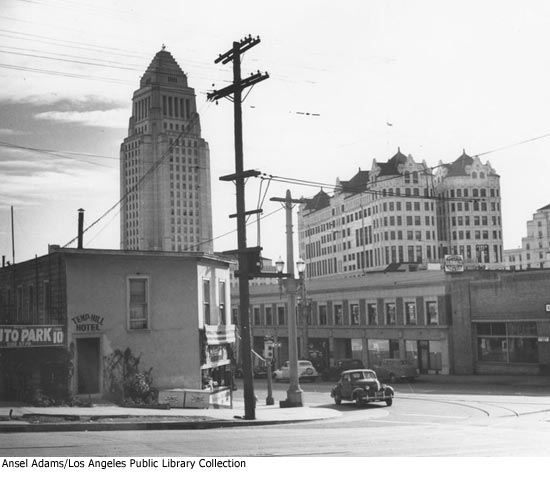
He gave the world majestic images of Yosemite, not to mention the unforgettable “Moonrise, Hernandez, New Mexico.” But Ansel Adams was no sentimentalist when it came to disposing of his old work.
In the early 1960s, the celebrated photographer happened upon a trove of negatives and small contact prints dating back to an assignment for Fortune magazine in Los Angeles. Some of his photos ran in the magazine’s March, 1941 issue with a story on the aerospace industry’s WWII buildup in Los Angeles.
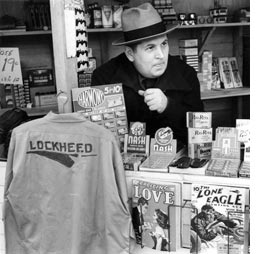
Ansel Adams/Los Angeles Public Library Collection
But Adams had photographed far more during the assignment—bowling parties, quirky architecture, trailer park life, a cemetery reposing next to oil wells. So he wrote to the Los Angeles Public Library offering the images not as art but as a slice of the city’s history. (His letter is here.)
“The weather was bad over a rather long period and none of the pictures were very good,” he wrote. “If they have no value whatsoever, please dispose of them in the incinerator.”
Fortunately, the city did not put the images out with the trash. The library accepted the photos and gave Adams a letter valuing them at $150 for his income tax purposes—more than the $100 valuation he’d suggested.
Since then, the photos have periodically been “rediscovered” and given a public viewing. (Here’s a link to Huell Howser’s “California’s Gold” segment; a Flickr gallery is here, and NPR’s online feature “The Picture Show” has featured them as well.)
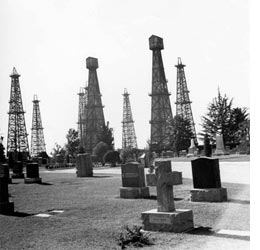
Ansel Adams/Los Angeles Public Library Collection
Fans of photography and Los Angeles history had a chance to learn more about the images during a free presentation last year at the library’s Los Feliz Branch. The presentation by Richard Stanley was part of the library’s “Architecture & Beyond” lecture series. (See details in update below of a gallery exhibition of the images that begins Feb. 18, 2012.)
“He photographed virtually the whole city, from Santa Anita to the Santa Monica Pier,” said Stanley, who’s a realtor as well as an Adams admirer and frequent photography lecturer in the series. The images demonstrate that Adams “was a working photographer, not just a fine artist.”
Christina Rice, acting senior librarian for the Los Angeles Library, last year initiated a three-month project to better present the images online and to research the historic (and often vanished) locations where the photos were made. But some of the details seem to have been lost to the ages—like the location of that cemetery by the oil wells.
Still, Rice said, “”from a Los Angeles history viewpoint, I think they’re amazing.”
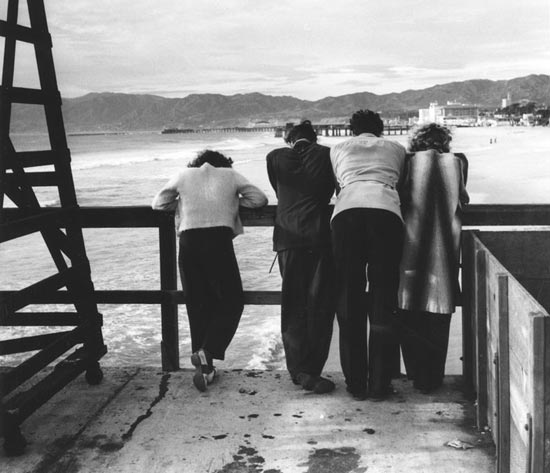
Ansel Adams/Los Angeles Public Library Collection
Posted 2/17/11
Updated 2/1/12: L.A. Observed reports that the photographs will be getting a gallery show, with sales benefitting the Library. The exhibit opens Feb. 18. Details are here.
New ER offers Rx for better care
February 16, 2011
For somebody who’s spent more than 20 years on the frontlines of life-and-death medicine, Johnnie Holmes was looking a lot like a kid in a candy store.
Holmes, a supervising charge nurse in the emergency room of Olive View-UCLA Medical Center, was breezing through the halls and treatment rooms of her new workplace this week and searching for adjectives to describe it all.
“Amazing,” “exciting” and “incredible” were all getting a workout.
After working in extremely cramped quarters to care for patients suffering from everything from gunshot wounds to gallstones, Holmes and her crew are about to start nursin’ large.
As in 31,000 square feet large—more than double the size of Olive View’s old emergency room. `
The new ER, unveiled at a ribbon-cutting ceremony on Monday, will begin serving patients on March 6.
Its 51 treatment areas include two “trauma/procedure rooms” for the sickest patients, seven rooms for cardiac patients and specialized rooms for obstetric-gynecological exams, eye problems and orthopedic needs.
The facility also features a separate isolation ward for patients with tuberculosis and other infectious diseases, as well as, potentially, victims of a bioterror attack.
In the new ER, tests such as CT scans, ultrasounds and basic lab work will all be done onsite, so patients won’t have to be transported across the hospital for such workups.
The ER’s gleaming new equipment includes a device called VeinViewer Vision, which uses light and digital imaging to allow nurses to, in effect, look through a patient’s skin to find a vein to insert an IV or to draw blood.
“This is an amazing machine,” Holmes said as she demonstrated the VeinViewer for visitors.
But it will take more than new technology to confront some of the ER’s biggest challenges. The ER’s patient load has grown by 15% over the past two recession-plagued years, from 40,000 patients to 46,000. That mirrors a trend seen in emergency rooms across the county recently, with high unemployment and people losing their health insurance.
A related issue is that Olive View’s ER, like other emergency rooms, has long waiting times–a problem the hospital has been working to address, with some success, even before the move to the new ER.
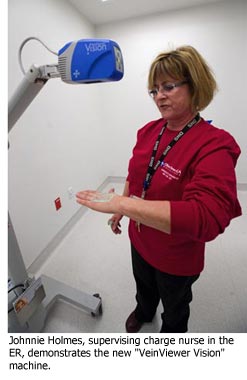 In the past 12 months, median wait times in Olive View’s emergency area dropped from just under three hours to just under two hours, despite the increased patient load, thanks to the addition of a physician to perform rapid medical screening exams. The overall length of stay for patients dropped from eight hours to seven. (Similar efforts to make sure the sickest patients are treated first are underway at other county facilities as well.)
In the past 12 months, median wait times in Olive View’s emergency area dropped from just under three hours to just under two hours, despite the increased patient load, thanks to the addition of a physician to perform rapid medical screening exams. The overall length of stay for patients dropped from eight hours to seven. (Similar efforts to make sure the sickest patients are treated first are underway at other county facilities as well.)
In hopes of continued improvement, Olive View officials are planning to add another nurse practitioner and to increase the physician staffing in the ER in the next four months, and have also hired a consultant to look at patient flow and staffing issues in the new space. They expect that greater efficiencies will come from having onsite labs and radiology, as well as a chest pain observation area and more versatile exam rooms and monitoring equipment.
Olive View is only public hospital serving the San Fernando, Santa Clarita and Antelope valleys, and is a key part of the county’s overall emergency services network. The new ER should allow Olive View to serve from 8,000 to 10,000 more emergency patients each year. The $53 million project, which started in 2002, finished nearly $1 million under budget and nine months early.
That’s good news for patients, who in addition to the long waits have gone without privacy and even beds, being treated in chairs or crammed into hallways on gurneys.
“We have the most incredible patients,” Holmes said. The new ER “is going to be less stressful for us and hopefully a lot less stressful for them.”
“You find yourself apologizing all the time,” she said. “All of the nurses go home with bruises on their thighs because they’re always running into gurneys. It will be amazing to have all that space.”
Holmes, 61, who worked for the folk rock duo Seals & Crofts (“Summer Breeze”) before becoming a nurse, now acts as a kind of air traffic controller in the ER, making sure the most urgent cases are seen first. In preparation for the new ER, she staged a scavenger hunt (with See’s truffles as prizes) to help nurses learn their way around the vastly larger space.
“It’s like a dream come true for all of us,” she said, even though she expects some “separation anxiety” among nurses who’ll be shifting from a single nursing station in the old ER to seven in the new space.
She said that–with the notable exception of the waiting times–public hospital emergency rooms provide care that equals or exceeds that offered in many private facilities.
“It always amazes me that people have a tendency to put down public hospitals. I’m here to tell you that, after being in private emergency rooms with my family members…they give the most amazing care here.”
The new emergency room is “first class,” said Supervisor Zev Yaroslavsky, who represented the Board of Supervisors at the inaugural event along with Supervisor Michael D. Antonovich. “The only thing missing right now is patients.”
Before the ribbon was cut, Dr. David Talan, chief of the hospital’s emergency medicine department, gave a shout-out to those patients. “Thank you for your trust. It’s an honor to help you…Above all else, the new Olive View emergency room is for our community and all of the people we are dedicated to serving.”
Talan also saluted his emergency department staff. “They’re here after everyone else goes home,” he said. “They have been doing their best under some very challenging circumstances.”
Posted 2/16/11
Local flavor blossoms at farmers’ markets
February 16, 2011
What’s fresh and green and fun all over? Farmers’ markets, of course—and the 3rd District is bursting with them. No longer just a place to find the makings for a locally-grown dinner, a thriving market is now a scene unto itself, complete with music, chatting, sampling, strolling and world-class people-watching.
Photos of Hollywood Farmers’ Market by Tali Stolzenberg-Myers
A virtual ridealong with the food cops
February 15, 2011
Inspectors with Los Angeles County’s street vending compliance program encounter a stomach-churning array of unsafe food preparation practices as they work with law enforcement to conduct regular raids across the region. These photos provided by the Department of Public Health offer a glimpse of what the inspectors come across, from illicit hot dog carts and unlicensed taquerias to raw meat and seemingly innocent fruit being stored at unhealthily warm temperatures. As the county moves forward with a proposal to issue letter grades to law-abiding mobile food vendors, its war on the outlaws continues unabated.
Leaf peeping, Beverly Hills-style
February 14, 2011
If you think of fall color as a strictly New England phenomenon, you haven’t visited the county’s Virginia Robinson Gardens in Beverly Hills. These photos, with radiant persimmon trees providing much of the autumnal mood, showcase some of what can be found in the Italian Terrace section of the garden as the weather gets cooler. Garden superintendent Tim Lindsay, who took the photos, notes that all the plants are drought-tolerant. “I try to capture it every year,” he said. “It just seems to get better.” Visitors require reservations for the garden’s guided tours, which are offered Tuesday through Friday. Admission prices and other information is here.
Posted 11/3/10
An autumn story, in living color
February 13, 2011
Southern California may specialize in the colorful and unexpected, but here’s something that even locals can appreciate as a novelty: From Topanga to Pomona, the hills and streets have turned scarlet and gold with fall foliage. And if the 2010 colors seem unusually vivid, botanists say, it’s not your imagination.
This year’s cooler-than-usual summer and fall, coupled with milder-than-usual Santa Anas, apparently have created the ideal conditions for a New England-style autumn in L.A.
“In the 12 years I’ve been here, this is the best I’ve seen,” said Frank McDonough, botanical information consultant at the Los Angeles County Arboretum and Botanic Garden. “I’m like a surfer on a big wave day.”
Some trees, he said, were changing color for the first time since he’d come to the arboretum.
“Look at that one!” he enthused, strolling with a visitor this week through stands of bright red Chinese Pistache and golden Ginkgo biloba. “Look at that one! Look at that one!”
(For a photo gallery and video tour of the arboretum, see below.)
Deciduous trees in Southern California tend to change colors later and with less visual drama than in cooler climates, but they do exist here, and do change. Poplars brighten the fall in places like Canyon Country and Acton. Crepe myrtles deck backyards in the San Fernando Valley; Liquidambars blaze along boulevards in Westwood and San Marino. Sycamores bring autumn gold to warm inland suburbs and rustic canyons.
But most autumns are too warm and windy for the leaves’ true colors to fully emerge before they dry up and get blown away by the desert winds, says McDonough. Leaves turn because of complex chemical changes triggered as temperatures drop and days shorten. Time plays a big part in the transition.
The bright autumn colors are actually what remain when dwindling sunlight and cooler weather signal the onset of winter, and the green chlorophyll in a leaf starts to dissipate as it stops producing food.
As the leaf’s green-ness ebbs, previously hidden orange and yellow pigments surface. Meanwhile, a red and sometimes blue pigment known as anthocyanin can be generated as cold night air chills the leaf, trapping sugars manufactured in warmer daylight. The result is the emergence of the season’s hallmark golden, copper, crimson and burgundy leaves.
“It’s a process that takes a while and requires cooler temperatures,” says McDonough. “But a lot of times here in Southern California, because we have such hot fall weather, that process doesn’t go very gracefully.”
This year has been different. First, an upper level trough off the coast gave Southern California one of the coldest summers since the National Weather Service began keeping records in the 1940s. Then, after a little September warmth, the soil and air were cooled again by a series of rainstorms.
“October was extremely wet,” notes Jim Ashby, service climatologist at the Western Regional Climate Center in Reno, NV. “Rainfall was 433% of normal at the Los Angeles [International] Airport in Los Angeles, and 254% of normal downtown.”
Then, after a brief heat wave in early November, the mercury again began dropping, with nighttime lows by the end of the month in the low- to mid-40s — coincidentally the perfect temperature for anthocyanin creation.
“It’s definitely been a different weather pattern,” says National Weather Service meteorologist Curt Kaplan.
And what better time to put on your walking shoes and enjoy it than now, in these final days of fall?
A fall day at the Arboretum. Photos by Zev’s Web Staff
Upload your Southern California autumn pictures on Zev’s website by clicking here.
Posted 12/9/10




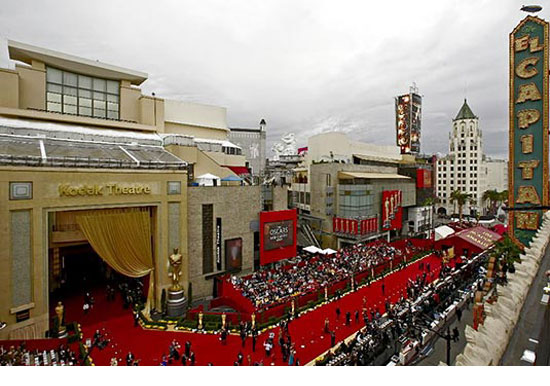
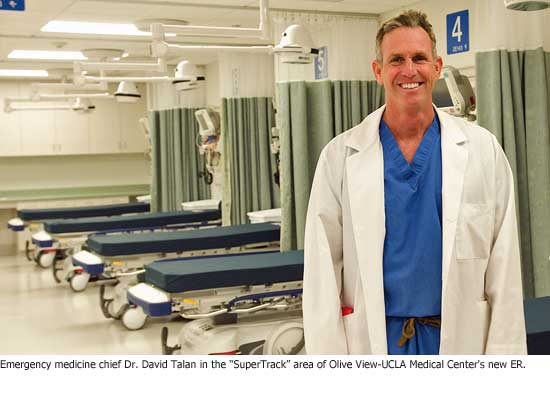















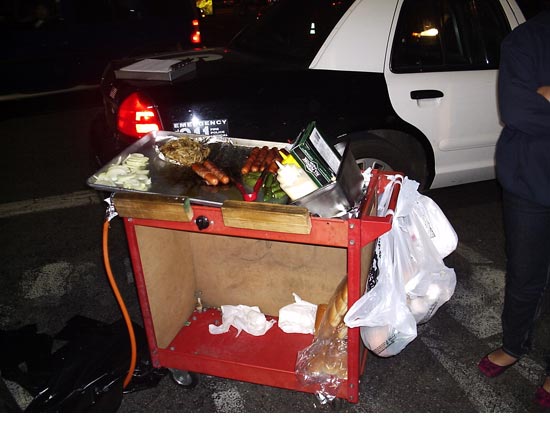










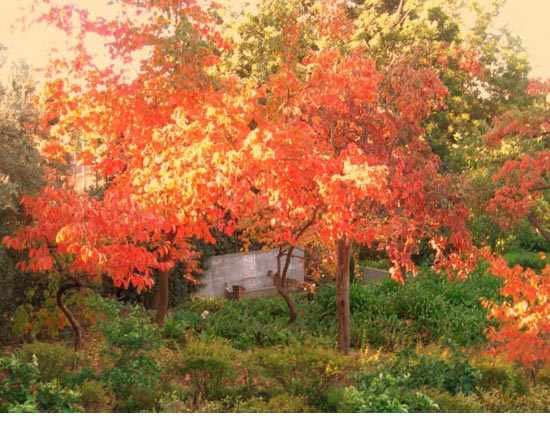










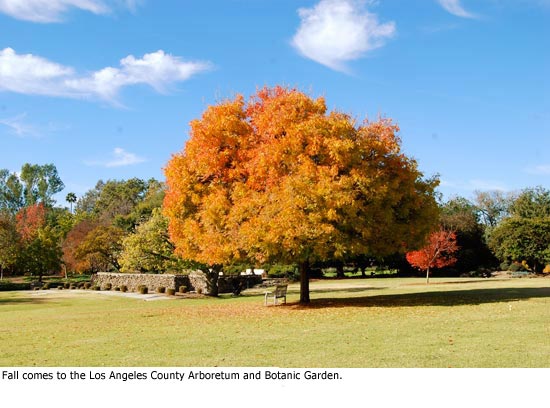
















 Check for the latest closure information
Check for the latest closure information








